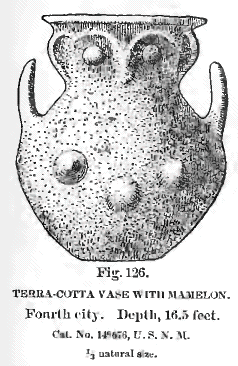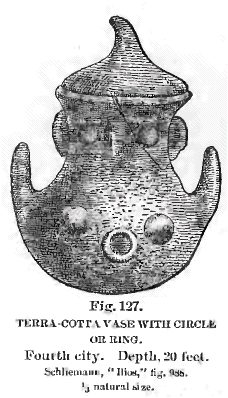

The Swastika
Dispersion of the Swastika
Professor Sayce is of the opinion, from the evidence of this leaden idol, that the Swastika was, among the Trojans, a symbol of the generative power of man.
An added interest centers in these specimens from the fact that terra-cotta
 shields
of similar triangular form, fitted to the curvature of the body,w ere
worn in the same way in prehistoric times by the aboriginal women of Brazil.
These pieces have small holes at the angles, apparently for suspension
by cords. The U.S. National Museum has some of these, and they will be
figured in the chapter related to Brazil. The similarity between these
distant objects is remarkable, whether they were related or not, and whether
they knowledge or custom came over by migration or not.
shields
of similar triangular form, fitted to the curvature of the body,w ere
worn in the same way in prehistoric times by the aboriginal women of Brazil.
These pieces have small holes at the angles, apparently for suspension
by cords. The U.S. National Museum has some of these, and they will be
figured in the chapter related to Brazil. The similarity between these
distant objects is remarkable, whether they were related or not, and whether
they knowledge or custom came over by migration or not.Owl-shaped vases. --- It is also remarkable to note in this connection the series of owl-shaped terra-cotta vases of the ruined cities of Hissarlik and their relation to the Swastika as a possible symbol of the generative power. These vases have rounded bottoms, wide bellies, high shoulders (the height of which is emphasized by the form and position of the handles), the mouth narrow and somewhat bottle shaped, but not entirely so. What would be the neck is much larger than usual for a bottle, and more like the neck of a human figure, which the object in its entirety represents in a rude, but, nevertheless, definite, manner. At the top of the vase are the eyes, eyebrows, and the nose. It is true that the round eyes, the arched eyebrows, and the pointed nose give it somewhat an owlish face, but if we look at fig. 127, the human appearance of which is emphasized by the cover of the vase, which serves
 as
a cap for the head and has the effect of enlarging it to respectable dimensions,
we will see how nearly it represents a human being. The US National Museum
possesses one of these vases in the Schliemann collection (fig. 126).
It has the face as described, while the other human organs are only indicated
by small knobs. It and the three figures, 127, 128,
and 129, form a series of which
the one in the Museum would be the first, the others following in the
order named. No. 2 in the series has the female attributes indefinitely
and rudely indicated, the lower organ being represented by a concentric
ring. In No. 3 the mammæ are well shown, while the other organ has
the concentric ring, the center of which is filled with a Greek cross
with four dots, one in each angle, the Croix swasticale of Zmigrodzki
(fig. 12). No. 4 of the series
is more perfect as a human, for the mouth is represented by a circle,
the mammæ are present, while in the other locality appears a well-defined
Swastika. The first three of these were found in the fourth city at 20
to 22 feet depth, respectively; the last was found in the fifth city at
a depth of 10 feet. The leaden idol (fig.
125), with its Swastika mark on the triangle covering the private
parts, may properly be considered as part of the series. When to this
series is added the folium ritus of Brazil (pl.
18), the similarity becomes significant, if not mysterious. But, with
all this significance and mystery, it appears to the author that this
sign, in its peculiar position, has an equal claim as a symbol of blessing,
happiness, good fortune, as that it represents the generative power.
as
a cap for the head and has the effect of enlarging it to respectable dimensions,
we will see how nearly it represents a human being. The US National Museum
possesses one of these vases in the Schliemann collection (fig. 126).
It has the face as described, while the other human organs are only indicated
by small knobs. It and the three figures, 127, 128,
and 129, form a series of which
the one in the Museum would be the first, the others following in the
order named. No. 2 in the series has the female attributes indefinitely
and rudely indicated, the lower organ being represented by a concentric
ring. In No. 3 the mammæ are well shown, while the other organ has
the concentric ring, the center of which is filled with a Greek cross
with four dots, one in each angle, the Croix swasticale of Zmigrodzki
(fig. 12). No. 4 of the series
is more perfect as a human, for the mouth is represented by a circle,
the mammæ are present, while in the other locality appears a well-defined
Swastika. The first three of these were found in the fourth city at 20
to 22 feet depth, respectively; the last was found in the fifth city at
a depth of 10 feet. The leaden idol (fig.
125), with its Swastika mark on the triangle covering the private
parts, may properly be considered as part of the series. When to this
series is added the folium ritus of Brazil (pl.
18), the similarity becomes significant, if not mysterious. But, with
all this significance and mystery, it appears to the author that this
sign, in its peculiar position, has an equal claim as a symbol of blessing,
happiness, good fortune, as that it represents the generative power.From the earliest time of which we have knowledge of the thoughts or desires of man we know that the raising up "heirs and his body" constituted his greatest blessing and happiness, the their failure his greatest misery. The first and greatest command of God to man, as set forth in the Holy Bible, is to "Be fruitful, and multiply, and replenish the earth." (1) This was repeated after the Deluge, (2)
and when He pronounced the curse in the Garden, that upon the woman (3) was, "In sorrow thou shalt bring forth children." God's greatest blessing to Abraham, when He gave to him and his seed the land as far as he could see, was that his seed should be as the dust of the earth, "so that if a
ENDNOTES:
1. Genesis i, 28. Back
2. Genesis viii, 17; ix, 7. Back
3. Genesis iii, 16. [Back]
<< Previous Page Next Page >>
© 2004-2007 Northvegr.
Most of the material on this site is in the public domain. However, many people have worked very hard to bring these texts to you so if you do use the work, we would appreciate it if you could give credit to both the Northvegr site and to the individuals who worked to bring you these texts. A small number of texts are copyrighted and cannot be used without the author's permission. Any text that is copyrighted will have a clear notation of such on the main index page for that text. Inquiries can be sent to info@northvegr.org. Northvegr™ and the Northvegr symbol are trademarks and service marks of the Northvegr Foundation.

|